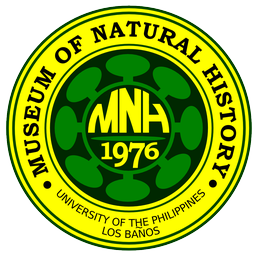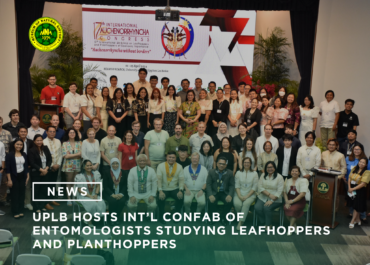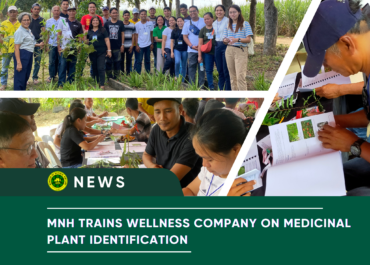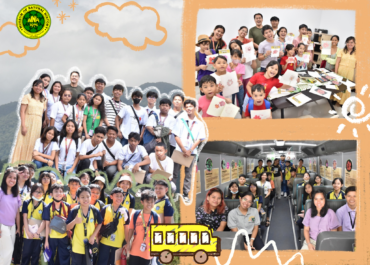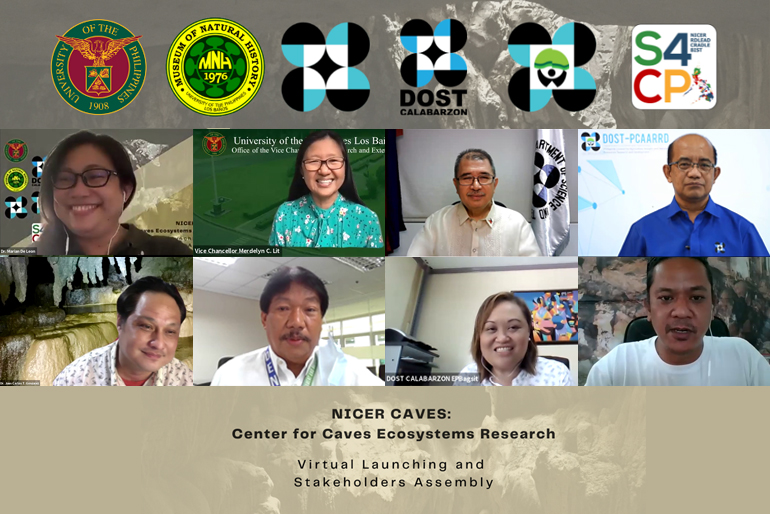
In simple ceremonies held via videoconferencing, the UPLB Museum of Natural History, with the support of its partners and stakeholders, launched today the Center for Cave Ecosystems Research (CAVES), a three-year, P 40M research program funded by the Department of Science and Technology (DOST) NICER Program.
The NICER (Niche Centers in the Regions for R&D) Program is a component of the Science for Change Program (S4CP) of the DOST which aims to accelerate the capacity building of R&D institutions and industrial competitiveness in the regions.
The opening program was attended by key officials from the University of the Philippines Los Baños (UPLB), Department of Science and Technology (DOST) and Department of Environmental and Natural Resources (DENR)-CALABARZON and more than 150 participants from the academe and government sectors.
Speaking on behalf of UPLB Chancellor Dr. Jose V. Camacho, Jr., Vice-chancellor for Research and Extension Dr. Merdelyn C. Lit congratulated the Museum and the collective work of its curators, core and project staff and technicians in achieving this milestone. “We highly commend everyone at the MNH for receiving this distinction, for becoming the first NICER-funded center of CALABARZON,” the vice-chancellor said during her welcome remarks.
According to Dr. Lit, caves are last-frontier ecosystems that need protection, and as well research, especially those which will lead to discoveries which may be useful to humans. “Caves will have a role in the future and understanding these environments will be essential in humans’ survival in extremely adverse environments,” she said.
Engineer Fortunato T. de La Pena, Secretary of the Philippines’ Department of Science and Technology echoed during his pre-recorded inspirational message that it is “just fitting that we launch the CAVES Program this June, designated as the National Environment Month.
“The CAVES program, which aims to conduct research which will redound to better cave biodiversity conservation management is highly important, especially because according to a study funded by the National Research Council of the Philippines, only 10% of the total karst areas of the country has been surveyed,” the Secretary said.
The DOST is supportive of R&D programs which address these gaps. “The NICER program of DOST supports higher education institutions (HEIs) through grants so that they can conduct quality research which will spur socio-economic growth, in this case, the CALABARZON region,” he explained.
“We at the DOST highly hope for the success of the partnerships among the stakeholders, such as DENR CALABARZON, the Regional Cave Committee, the non-government organizations and local government units,” Secretary dela Peña said.
He also challenged the Museum to essentially become a national center for cave research in the future.
The DOST-Philippine Council for Agriculture, Aquatic, Forestry and Natural Resources Research and Development (PCAARRD), which will monitor the implementation of the program by the MNH, has also commended the Museum for the program launch.
Dr. Reynaldo V. Ebora, DOST-PCAARRD executive director, said that the MNH’s expertise and past and future studies will play a big role in the agency’s achieving its industry strategic plans for biodiversity. “PCAARRD’s thrusts not only involve the conservation, but also the judicious use of biodiversity resources, and biodiversity-based products and services,” he said in a pre-recorded message.
“We look forward to supporting our partners, especially the UPLB and the Museum, in the Agriculture, Aquatic, Forestry and Natural Resources sector,” the director said.
Speaking live from the DOST-CALABARZON headquarters, Emelita P. Bagsit, officer-in-charge of the Office of the Regional Director of DOST Region IV-A said that her agency is excited to support the NICER CAVES program. “We congratulate everyone for this first-ever NICER program in CALABARZON; it will be challenging, but we are really excited, nonetheless,” she shared.
Also, Forester Alfredo C. Palencia, DENR CALABARZON OIC Assistant Regional Director for Technical Services and Chair of the Regional Cave Committee (RCC) intimated that having the CAVES Program will be beneficial to the region. According to Palencia, CALABARZON has assessed 79 caves but only 17 and 45 caves are classified as Class I and II, respectively. The RCC wholeheartedly supports the program and will definitely be on board in the assessment and classification of the caves. “We will complement each other for the successful implementation of the program,” the official said.
Tayabas City Environmental Resource Officer Melvin C. Rada expressed their city’s support in terms of equipment, manpower and community action in information communication and education, and the enactment of ordinances consistent with the national policies. “We at the city ENRO are excited because our scientific knowledge is limited and exchanges with the scientific community will be beneficial to both parties,” he shared.
The CAVES Program officially started in February 2021 and will be implemented until 2024. The targeted caves to be studied are Cabag Cave in Maragondon, Cavite; Cathedral Cave in Cavinti, Laguna; Alegre Cave in Lobo, Batangas; Pamitinan Cave in Rodriguez, Rizal and San Juan Cave in Tayabas, Quezon.
In her closing remarks, Museum Director Marian P. De Leon relayed the gratitude of the whole organization for the support of its numerous partners.
“We are truly grateful to the whole DOST family led by Secretary de la Peña and Undersecretary for Research and Development Dr. Rowena l. Guevarra, for providing this great opportunity for the Museum to further serve the country. of course, to Chancellor Camacho and Vice-Chancellor Lit for their unwavering support to the MNH’s initiatives,” Dr. De Leon said.
Thank you to the DENR organization and the LGU-beneficiaries for their support, we will do our best and rise up to the challenge to become the hub of research and information which will be the basis of policies, products and services which will ultimately benefit our communities and region,” she ended.
Search
Archives
Categories
- Announcement (21)
- Feature (21)
- News (141)
- Press Release (55)
- Research (4)
- Services (3)
